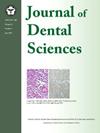Accuracy and fitness of digital light processing-fabricated resin-based permanent crowns after thermal aging
IF 3.1
3区 医学
Q1 DENTISTRY, ORAL SURGERY & MEDICINE
引用次数: 0
Abstract
Background/purpose
Resin-based materials fabricated using digital light processing (DLP) have received increasing attention for use in permanent dental restorations. This study investigated the accuracy and fit of DLP-fabricated resin-based permanent crowns before and after thermal aging.
Materials and methods
A maxillary right first premolar resin tooth was scanned and digitally designed as a reference computer-aided design (CAD) model. Twenty DLP-fabricated permanent resin crowns were produced. Half of the specimens remained unaged, while the others underwent thermal aging through 10,000 cycles between 5 °C and 55 °C. To evaluate crown accuracy, trueness was assessed by comparing virtual models of the fabricated crowns to the design reference model. Precision was evaluated through inter-sample comparisons among the virtual models of the fabricated crowns. Color difference maps were generated for four distinct crown regions, and root mean square (RMS) values were calculated for each. Crown fitness was evaluated using the silicone replica method by measuring silicone thickness at four intaglio areas with a digital microscope. Data differences before and after thermal aging were analyzed using paired t-tests (α = 0.05).
Results
Thermal aging significantly increased RMS values for external surface trueness (P < 0.001). Marginal and internal gaps remained within the clinically acceptable discrepancy threshold of 120 μm. Significant differences were observed in the marginal and occlusal gaps in both the coronal and sagittal planes after aging.
Conclusion
DLP-fabricated resin permanent crowns demonstrated acceptable trueness and clinically acceptable marginal and internal fitness. However, thermal aging reduced both the accuracy and fitness of these crowns.
数字光加工树脂基永冠热老化后的精度和适应性
背景/目的利用数字光处理技术(DLP)制备树脂基材料在永久性牙齿修复中的应用越来越受到关注。研究了热老化前后dlp树脂基永冠的精度和配合度。材料与方法对上颌第一前磨牙树脂牙进行扫描和数字化设计,作为参考计算机辅助设计(CAD)模型。制作了20个dlp制作的永久树脂冠。一半的样品保持未老化状态,而其他样品则在5°C至55°C之间进行了10,000次热老化。为了评估冠精度,通过将虚拟模型与设计参考模型进行比较来评估冠的真实性。通过制作冠的虚拟模型之间的样本间比较来评估精度。生成四个不同冠区色差图,并计算每个区域的均方根(RMS)值。在数码显微镜下测量四个凹印区硅胶厚度,采用硅胶复制法评价冠适合度。采用配对t检验分析热老化前后数据差异(α = 0.05)。结果热老化显著提高了外表面真实度的均方根值(P < 0.001)。边缘和内部间隙保持在临床可接受的差异阈值120 μm以内。衰老后冠状面和矢状面牙合间隙和牙合间隙均有显著差异。结论dlp制作的树脂全冠具有良好的真实度和临床可接受的边缘和内部适合度。然而,热老化降低了这些冠的准确性和适应度。
本文章由计算机程序翻译,如有差异,请以英文原文为准。
求助全文
约1分钟内获得全文
求助全文
来源期刊

Journal of Dental Sciences
医学-牙科与口腔外科
CiteScore
5.10
自引率
14.30%
发文量
348
审稿时长
6 days
期刊介绍:
he Journal of Dental Sciences (JDS), published quarterly, is the official and open access publication of the Association for Dental Sciences of the Republic of China (ADS-ROC). The precedent journal of the JDS is the Chinese Dental Journal (CDJ) which had already been covered by MEDLINE in 1988. As the CDJ continued to prove its importance in the region, the ADS-ROC decided to move to the international community by publishing an English journal. Hence, the birth of the JDS in 2006. The JDS is indexed in the SCI Expanded since 2008. It is also indexed in Scopus, and EMCare, ScienceDirect, SIIC Data Bases.
The topics covered by the JDS include all fields of basic and clinical dentistry. Some manuscripts focusing on the study of certain endemic diseases such as dental caries and periodontal diseases in particular regions of any country as well as oral pre-cancers, oral cancers, and oral submucous fibrosis related to betel nut chewing habit are also considered for publication. Besides, the JDS also publishes articles about the efficacy of a new treatment modality on oral verrucous hyperplasia or early oral squamous cell carcinoma.
 求助内容:
求助内容: 应助结果提醒方式:
应助结果提醒方式:


